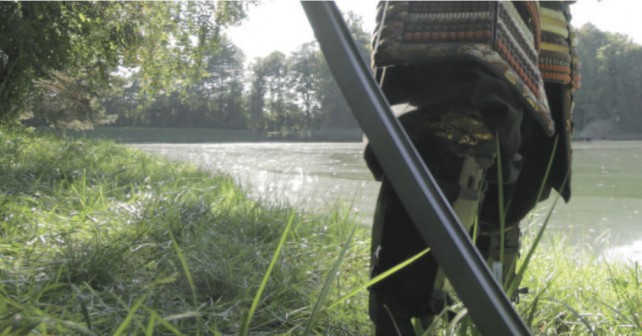
It is freezing cold, a group of white dressed people is treading through knuckle deep snow. The sound of the Horagai, (the Japanese conch shell horn), tears apart the silence and from a faraway place resonates the thunderous rushing of the Waterfall.
We are in Europe, in the Austrian Alps, were a group of Shugenja is on its way for practicing Takigyo, a Meditation inside the current of a Waterfall.
Since his Childhood, Christian Grübl trains Japanese Martial Arts and almost as long he teaches them. In his Dojo Karate, Ninjutsu and Yagyu Shinkage Ryu are passed down to his students in a non-sporty but more Traditional Way. Ten years ago through Martial Arts he found his path to Buddhism and thus to Shugendo. His Teacher Shokai Koshikidake from whom he received his initiation as Yamabushi Monk is Head and Grandmaster of the oldest Shugendo Tradition.
But what exactly does Shugendo mean and who are the Yamabushi Monks who are sometimes associated with the Ninja, Japanese Shadow Warriors? Is there any linkage to be found to the mythical skills and powers of the legendary Shinobi?
Soke Shokai Koshikidake:
Shugendo is the Mountain Religion. Why the Mountain is important for this Religion is based on one of the fundamental teachings indwelling in us from ancient Times in Japan. We worship in the Mountain as the spirit World. The Mountain is the Place where Spirit of Ancestors and Gods gather. The Mountain sometimes represented the Border and Barrier betwe- en this World and another World.
To realize this spiritual World, we have to release our Sense comes from the material World. We have to put out the six Sense organs; eyes, ears, nose, tongue, and mind. For that purpose, we hold perform the Ceremonies of ritualistic Death and Rebirth in the Mountain. These ritualistic performances enable us to experience for ourselves the state of being able to escape from the suffering of the transmigration of souls.
The ritualistic Death gives us the release of the Soul from our Body. And we start the travel to the inner World of the Universe.
Sensei Christian Grübl:
Actually, the Yamabushi Monks have nothing to do with Martial Arts, however in the ancient Times of Japan existed the so called “Sohei”, who were armed buddhist Monks trained in the Martial Arts. Some of them were highly influential on politics.
“The Mountain is the Place where Spirit of Ancestors and Gods gather. The Mountain sometimes represented the Border and Barrier between this World and another World”
The Japanese Ninja Warriors on the other hand are often being associated with the techniques of “Kuji in” and “Kuji kiri”, the magical hand gestures commonly shown in Ninja Movies. This indeed would link them to the Yamabushi but it these performances have an entirely unlike meaning than depicted.
Kuji is used for a sacred dialog between the practitioner and a certain meditational deity, a transcenden- tal form of Buddha. It is not meant to be used for empowering a warrior with supernatural powers or demoralize and destroy his foes.
[..]
Neugierig geworden? Lies den kompletten Artikel in der Juni-Ausgabe der Kampfkunst International..
DVDs und Bücher zu deiner Kampfkunst findest du hier bei Budo International
Text und Bilder: Kampfkunst International


Keine Antworten zu “Shugendo und Bujutsu”